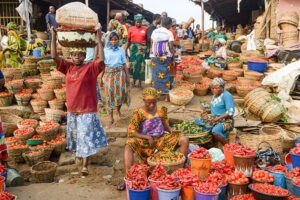 Nigeria’s inflation rate in the month of July 2022 rose to a 17-year high of 19.64%. This compares to 18.6% recorded in the previous month of June 2022.
Nigeria’s inflation rate in the month of July 2022 rose to a 17-year high of 19.64%. This compares to 18.6% recorded in the previous month of June 2022.
The latest inflation data is according to the recently released Consumer Price Index (CPI) report for the month of July 2022, by the National Bureau of Statistics (NBS).
“On a month-on-month basis, the Headline inflation rate in July 2022 was 1.817 %, which was 0.001% higher than the rate recorded in June 2022 (1.816 %),” the NBS said.
“The percentage change in the average CPI for the twelve months period ending July 2022 over the average of the CPI for the previous twelve months period was 16.75%, showing a 0.46% increase compared to 16.30% recorded in July 2021.”
According to the NBS report, the country’s urban inflation increased by 2.08% to 20.09% in July 2022 from 18.01% in July 2021. On the other hand, the rural inflation rate reached 19.22% from 16.75% in the corresponding period of 2021.
“On a month-on-month basis, the food inflation rate in July was 2.04%, this was a 0.01% insignificant decline compared to the rate recorded in June 2022 (2.05%),” the agency equally noted in its latest report.
“This decline is attributed to a reduction in the prices of some food items like Tubers, Maize, Garri, and Vegetables.
“The average annual rate of food inflation for the twelve-month period ending July 2022 over the previous twelve-month average was 18.75%, which was a 1.42% points decline from the average annual rate of change recorded in July 2021 (20.16%).”
On inflation rates across states in the country, the report added: “In July 2022, all items’ inflation rate on a year-on-year basis was highest in Akwa Ibom (22.88%), Ebonyi (22.51%), Kogi (22.08%), while Jigawa (16.62%), Kaduna (17.04%) and Borno (18.04%) recorded the slowest rise in headline Year-on-Year inflation.
“However, on a month-on-month basis, July 2022 recorded the highest increases in Adamawa (2.87%), Abuja (2.84%), Oyo (2.77%), while Bauchi (0.82%), Kano (0.83%) and Niger (1.03%) recorded the slowest rise on month-on-month inflation.”

Supreme Court Invalidates National Lottery Act, Restricts Enforcement To FCT
House Of Reps Rejects Six-Year Single Term Bill For President, Governors
Senate Approves ₦1.77 Trillion Loan Request By President Tinubu
Finland Arrests Pro-Biafran Agitator Simon Ekpa On Terror Charges